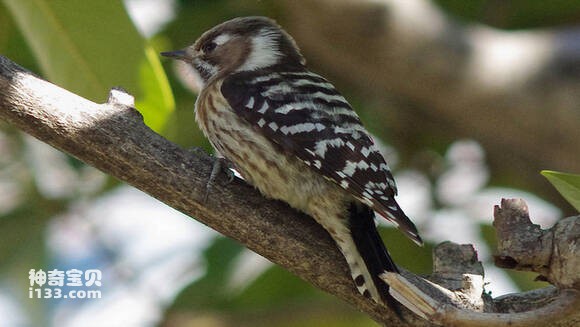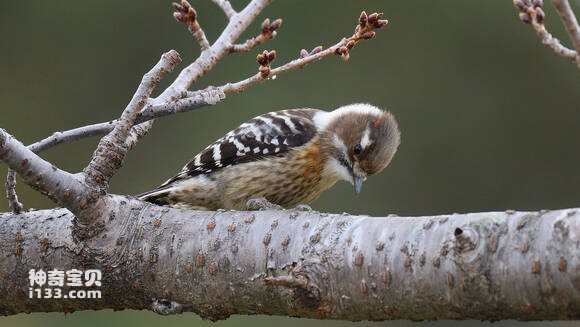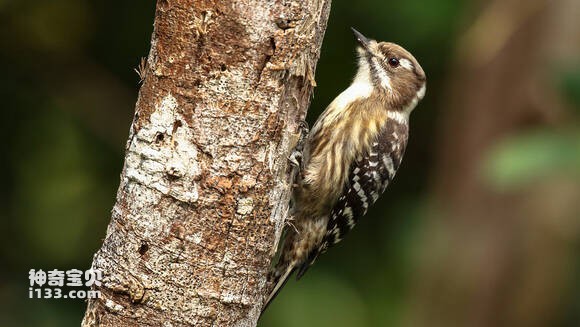Dendrocopos kizuki
IUCN
LCBasic Information
Scientific classification
- name:Dendrocopos kizuki
- Scientific Name:Dendrocopos kizuki,Yungipicus kizuki,Japanese pygmy woodpecker
- Outline:Climbing birds
- Family:
Vital signs
- length:12-16cm
- Weight:20-22g
- lifetime:No textual research information is available
Feature
Distribution and Habitat
The species is found in southeastern Heilongjiang, Changbai Mountain in Jilin, eastern and southern Liaoning, Dongling in Hebei and Dexian in Shandong Province. Outside China, it is found in the Russian Far East, Ussuri, Sakhalin, Korea, Japan, and the Ryukyu Islands.
Small starheaded woodpecker mainly lives in coniferous forest, mixed coniferous broad-leaved forest and broad-leaved forest, and even appears in Yue birch forest at 1700 meters above sea level in Changbai Mountain, and often forages in forest margins and secondary forests in early spring and autumn and winter.
Appearance
The male bird's forehead to the top of the head is light grayish-brown, cheek, ear covering feathers to the side of the neck brown, or with brown and white feathers; The brow line is white, extending backward to the nape, and associated with the white spot on the side of the neck. The forehead is white, the pillow to the back neck is lead black, and the back pillow has a vermilion fine line immediately after the white brow line on both sides; The back, shoulder and inner wings are dark brown with white stripes or markings, especially the white stripes in the middle of the back. The white spots on the lower back are dense, and the covering feathers from waist to tail are black. The tail is also black, with white stripes on the outer tail feathers. The wings are mixed black and white. The small cover feathers on the wings are black brown, the middle cover feathers and the large cover feathers are only white in the middle, and the rest are black brown. The fly feathers are black, wit
Details
Dendrocopos kizuki, Yungipicus kizuki, and Japanese pygmy woodpecker have four subspecies。

Small star-headed woodpeckers are resident birds, often active alone except during the breeding period, and can be found in family groups of 3-5 individuals in the later breeding period. Usually, the sound is low and monotonous, like "Zha", and the cry is loud, high-pitched "khit" or "khit-khit-khit" and the continuous "kzz-kzz" sound and tapping. The wings flap greatly during flight. Often fly from one tree to another to feed, generally from the tree to the bottom of another tree, and then climb up the tree to feed. It mainly feeds on various insects and larvae such as Chrysozoon, Longiceps, Minutus, pyritiger, Coleoptera, etc., and occasionally eats plant fruits and seeds。

The breeding period of the small star-headed Woodpecker is from April to June. In late March, pairs have been paired and courtship behavior has appeared, often flying and chasing through the canopy, while flying and calling. Nest on broadleaf trees with rotten heartwood such as poplars and manchuria. In late April, the nest began to be pecked by both male and female birds. The height of the nest hole from the ground is mostly 3-11 meters, the diameter of the opening is 3.5-4.5 cm, the inner diameter of the hole is 7-8 cm, and the depth of the hole is 14-16 cm. The nest is empty of any interior material, and sometimes a few wood chips remain. Spawning begins in early May, breeding 1 litter a year, laying 4-7 eggs per litter, usually 5. Oval white, smooth without spots, 19 mm x 15 mm in size. Male and female birds incubate their eggs in turn. The chicks are late sex and are fed by both sexes.

It was included in the List of Beneficial Terrestrial Wildlife under State Protection or of Important economic and scientific research Value issued by the State Forestry Administration of China on August 1, 2000.
Listed on the International Union for Conservation of Nature (IUCN) 2012 Red List of Threatened Species ver 3.1 - Not Threatened (LC).
Protect wild animals and eliminate wild meat.
Maintaining ecological balance is everyone's responsibility!








